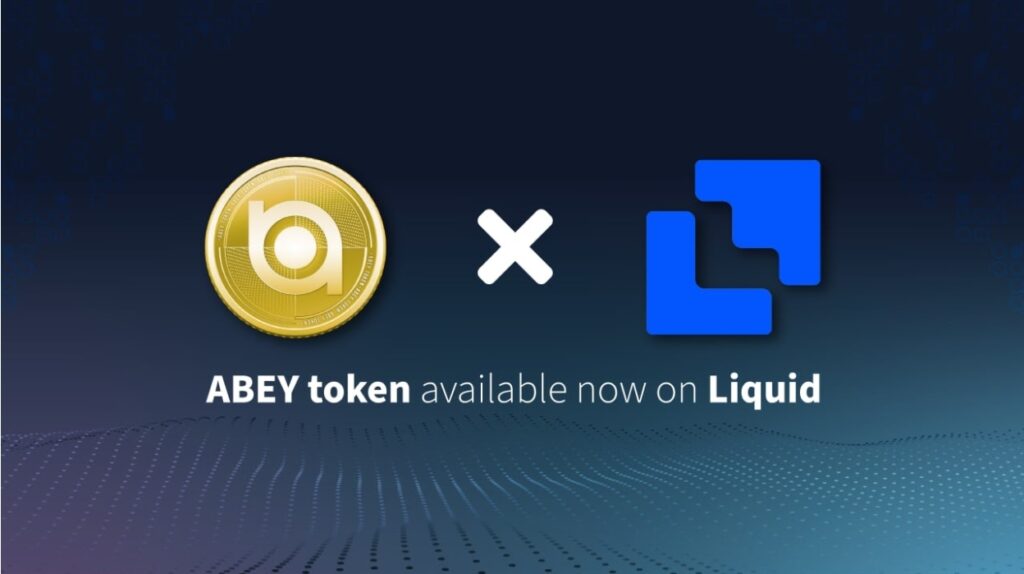
Today’s breaking news in the world of tokens includes the addition of a new token, ABEY, to the large crypto exchange, Liquid Global. The ABEY token is the native token on ABEYCHAIN, a third-generation blockchain that offers scalability through the unique combination of multiple consensus methods.
It’s the second listing on a major exchange for the ABEY token, as Liquid Global follows the ZBX.one exchange, which listed ABEY at $0.61 in 2020. The price of the token has jumped over 400%, now trading at around $2.50
Based on daily traded spot volume, Liquid is consistently ranked among the top 10-20 regulated cryptocurrency exchanges globally, home to more than 800,000 crypto traders and enthusiasts and operating in over 100 countries. With 80 tokens listed, Liquid Global recently achieved an all-time high of more than US$1.1B trade volume in 2021.
This listing on Liquid will serve as a new milestone for the ABEY Foundation, as it looks to make the ABEY token available to even more people around the world. With this new listing, ABEY token looks to continue its upward price trajectory as it gains exposure to Liquid’s massive user base.
Scalability remains a fervently debated topic. The engineers behind ABEYCHAIN are betting that the combination of Delegated Proof-of-Stake (DPoS) and Proof-of-Work (PoW) consensus enables a multi-layered blockchain without the trade-off between decentralization, security, and efficiency.
Projects valuing speed often compromise decentralization. Whereas on Bitcoin, attempts at scaling have taken place on a second layer with technologies such as Lightning Network and RSK seemingly leading the way, Ethereum’s core team has taken a different approach: redesigning the blockchain from the ground up and redeploying as eth2. Ethereum side chain Polygon has captured the imagination of blockchain scaling enthusiasts looking to scale eth2 and lower gas costs, layer one protocols have long investigated the topic.
ABEYCHAIN solves these challenges on an entirely new chain. The wisdom of past blockchain experiments has been built into the technology. A long line of white papers, academic papers, social media debates and more have pushed the concept of efficient, public-based consensus forward. In the view of ABEYCHAIN’s engineers, this history of thinking on the topic points towards the double consensus mechanism with the specific implementation of DPoS and PoW.
DPoS consensus algorithm ensures blockchain security, while allowing participants to govern the network through a form of digital democracy. Dan Larimer originally designed the DPoS system. He is an American software developer and founder of BitShares, Steemit, and EISIO. Blockchains built on top of DPoS platforms include Wax, Worbli, and more. Well-known DPoS blockchains include Lisk, Steem, Waykichain, EOS, and BitShares.
While PoW is incorporated to afford blockchain security and decentralization, it lacks elements of governance. This was precisely OG Bitcoin developer Mike Hearn’s critique when Bitcoin failed to scale. He believed Bitcoin’s lack of on-chain governance undermined its ability to adapt.
Supplementing PoW with DPoS could be the solution to this conundrum. DPoS allows for participants in the system to govern the system with voting and elections designed primarily to protect blockchain from malicious actors and more. On a DPoS blockchain, users specifically vote and elect delegates to validate the next block. Delegates might also be called witness or block producers in a DPoS system.
Another central argument for DPoS is its more efficient use of energy when compared to first and second-generation blockchains. Bitcoin is notoriously inefficient when it comes to energy usage, and the world has taken notice. Tesla stopped accepting Bitcoin for its electrical vehicles after the story of Bitcoin’s energy use wouldn’t go away. DPoS has proven to be effective at addressing this age-old blockchain challenge. The diminished energy consumption DPoS provides makes for less expensive transactions.
Since Bitcoin failed to scale its technology, at least in the eyes of many, the use cases for Bitcoin have only multiplied. Satoshi Nakamoto’s original blockchain has in many ways been left behind, as blockchain has proven useful in decentralized finance (DeFi), non-fungible tokens (NFTs), as well as cryptocurrency as a medium of exchange.
Most DeFi apps have been built on Ethereum. As the use of so-called dApps (decentralized applications used to run DeFi) has increased over the years, we’ve seen increasing strains placed on Ethereum, leading the team to rebuild the protocol from scratch; that is, eth2.
While Bitcoin lacks a governance model, Ethereum’s governance shortcomings have been well documented. A PoW and DPoS fusing blockchain could create fairness, lending all users a voice and power. ABEYCHAIN uses these concepts to scale the future of global blockchain infrastructure.



